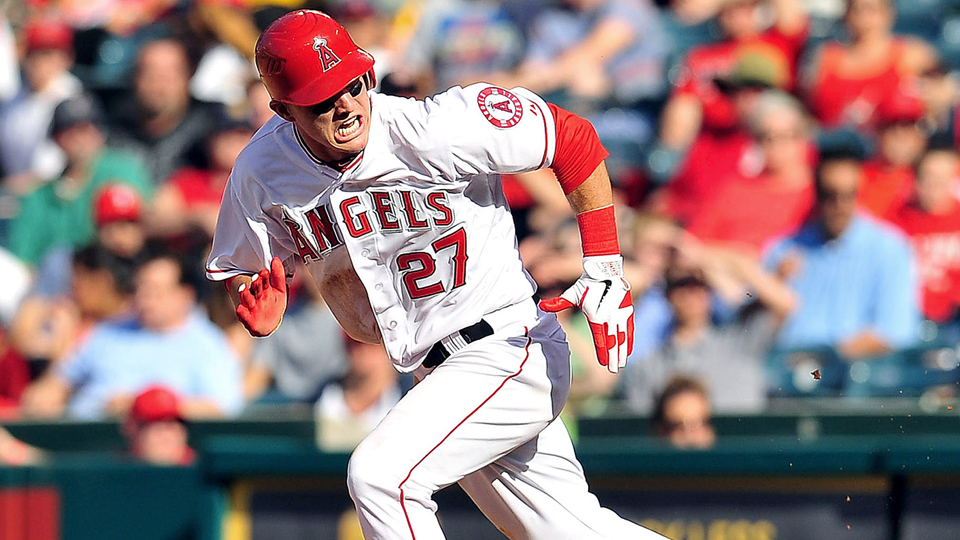Relax, my fellow peace-loving students. I’m not here to talk about techniques for solving serious conflicts between factions. Or maybe I am.
WAR, or wins above replacement, is a historically recent statistic in baseball that will help solve many MVP debates past, present, and future. It measures by how much one player is better than his hypothetical replacement. While there are several different formulae used, all of them involve a judgement of how well a player performs as a batter, base runner, or fielder, and also takes into account the player’s position.
Last season, fans saw brilliant performances from the Detroit Tigers’ Miguel Cabrera and the Los Angeles Angels’ Mike Trout. In 697 plate appearances, Cabrera slugged 44 homers, drove in 139 runs, scored 109 runs, walked 66 times, and chalked up 205 hits for a triple slash of .330/.393/.606 (batting average/on-base percentage/slugging percentage). Not to be outdone, the 20-year-old Trout, in 639 plate appearances, scored a league-leading 129 runs, drove in 83, slugged 30 homers, and even stole 49 bases for a triple slash of .326/.399/.564. Fans were and still are split on who deserves the MVP award.
Cabrera supporters will note that the Tigers were missing the services of their designated hitter, Victor Martinez, while Alex Avila, Brennan Boesch, and Jhonny Peralta all had disappointing seasons. Cabrera, along with newcomer Prince Fielder, picked up the slack by combining for 74 home runs and 247 RBIs. Outfielder Austin Jackson also had a breakout season, setting tables for the power-hitting duo and getting a triple slash of .300/.377/.479 in 617 plate appearances. With the trio energizing the otherwise questionable lineup, the Tigers made it to the postseason, where they lost in the World Series to the Cardinals.
Interestingly, Cabrera was the first person to win the batting triple crown (leading the league in home runs, RBIs, and batting average) since Carl Yastrzemski in 1967. As Paul Clark, a first-year biology student, notes, “It’s not every day you get to see a guy win a triple crown.”
Fans of Mike Trout, however, will say that besides being an offensive standout, he is also a brilliant defender, constantly robbing opponents of hits. Harry Lee, a first-year linguistics student, agrees. “It’s like I’m seeing him in highlights every single week,” he says. “You see him jumping and diving all the time.”
With Torii Hunter and Albert Pujols behind him in the lineup, Trout certainly did his job by getting on base almost 40% of the time, and he is a centre fielder to boot. Not many centre fielders, past or present, can both hit and field as well as Trout. While he is no match for Cabrera in power, his speed is rivalled by few in the league. He only grounded into seven double plays, compared to Cabrera’s league-leading 28. Despite being only 20 years old, he has already established himself as one of the top players in the game.
And when two players have both had excellent seasons, that’s when WAR comes in.
To understand why one player is more valuable than the other, one must realize that many of the stats are influenced by the performance of player’s teammates. For example, if your team can’t drive you in, you can’t score runs. If no one is on base, you have to hit a home run to get an RBI. Also, if you are a corner infielder, you are expected to hit well, whereas the bar is much lower for a centre fielder, since there aren’t many centre fielders who can hit well, this being a premium defensive position.
Now, baseball-reference.com lists Trout at 10.7 WAR, and Cabrera at 6.9. So why the huge gap?
It’s quite simple, actually, when you examine everything closely. There are many ways to put up value, so home runs, RBIs, and batting average aren’t the be-all and end-all. Since their batting average and on-base percentage are nearly identical, the difference came from elsewhere. Cabrera drove in more runs, but Trout scored many more. There is no evidence to suggest that Cabrera can’t score runs if he bats second, or that Trout can’t drive in runs if he bats cleanup. While Cabrera had a much higher slugging percentage, Trout grounded into many fewer double players than Cabrera did. In addition, Cabrera is reputed to be a horrible defender (and the stats agree), whereas Trout is commonly seen by both casual fans and analysts as a human highlight reel. Plus, Trout is the superior base runner, stealing 49 bases compared to Cabrera’s four.
Moving bases may seem insignificant, but consider this: a fast runner has a better chance to score from second on a single to the outfield, while there is no possible way for a runner to score from first on a single, barring errors. Cabrera is a touch better as a batter, but Trout is simply a better base runner and fielder. Also, the fact that the average third-baseman is a much better hitter than the average centre fielder needs to be taken into account, since WAR measures one’s production compared to a replacement player’s potential production. The triple crown, although a rare feat, adds no extra value to what a player brings to a team.
As both WAR and careful thinking would indicate, Trout got snubbed. 2013 should be his.

